Field evaluation of the establishment potential of wMelPop Wolbachia in Australia and Vietnam for dengue control
- PMID: 26510523
- PMCID: PMC4625535
- DOI: 10.1186/s13071-015-1174-x
Field evaluation of the establishment potential of wMelPop Wolbachia in Australia and Vietnam for dengue control
Abstract
Background: Introduced Wolbachia bacteria can influence the susceptibility of Aedes aegypti mosquitoes to arboviral infections as well as having detrimental effects on host fitness. Previous field trials demonstrated that the wMel strain of Wolbachia effectively and durably invades Ae. aegypti populations. Here we report on trials of a second strain, wMelPop-PGYP Wolbachia, in field sites in northern Australia (Machans Beach and Babinda) and central Vietnam (Tri Nguyen, Hon Mieu Island), each with contrasting natural Ae. aegypti densities.
Methods: Mosquitoes were released at the adult or pupal stages for different lengths of time at the sites depending on changes in Wolbachia frequency as assessed through PCR assays of material collected through Biogents-Sentinel (BG-S) traps and ovitraps. Adult numbers were also monitored through BG-S traps. Changes in Wolbachia frequency were compared across hamlets or house blocks.
Results: Releases of adult wMelPop-Ae. aegypti resulted in the transient invasion of wMelPop in all three field sites. Invasion at the Australian sites was heterogeneous, reflecting a slower rate of invasion in locations where background mosquito numbers were high. In contrast, invasion across Tri Nguyen was relatively uniform. After cessation of releases, the frequency of wMelPop declined in all sites, most rapidly in Babinda and Tri Nguyen. Within Machans Beach the rate of decrease varied among areas, and wMelPop was detected for several months in an area with a relatively low mosquito density.
Conclusions: These findings highlight challenges associated with releasing Wolbachia-Ae. aegypti combinations with low fitness, albeit strong virus interference properties, as a means of sustainable control of dengue virus transmission.
Figures
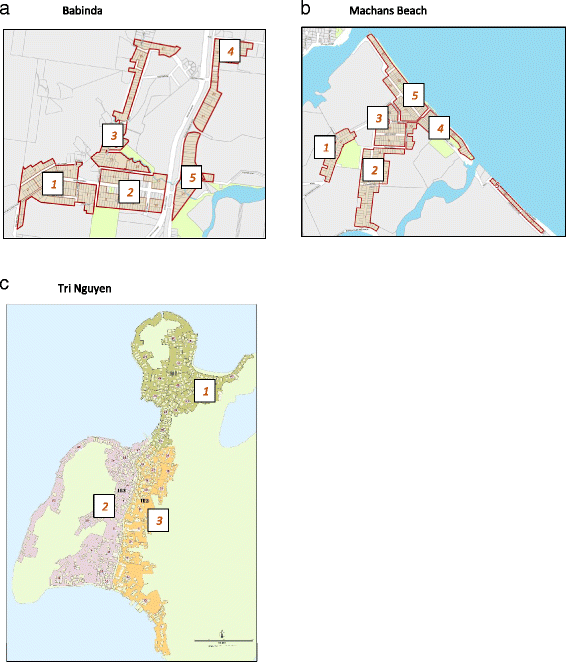
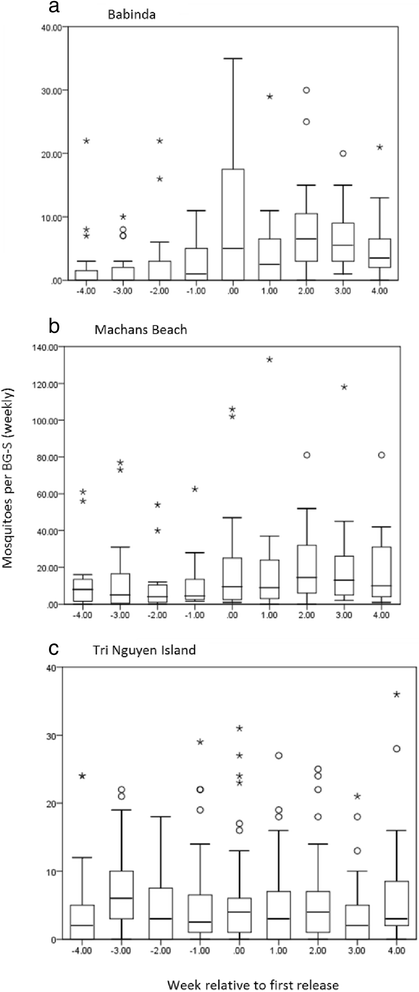
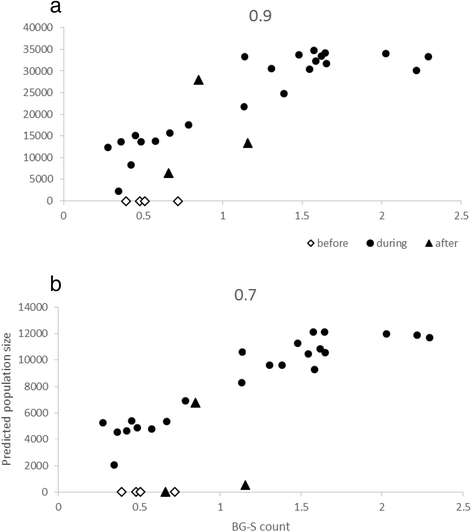
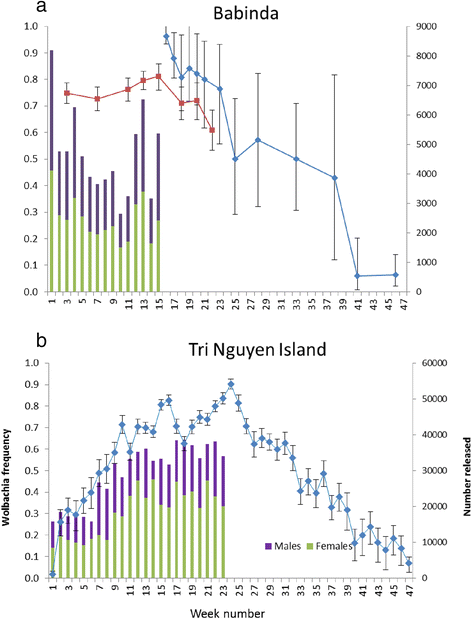
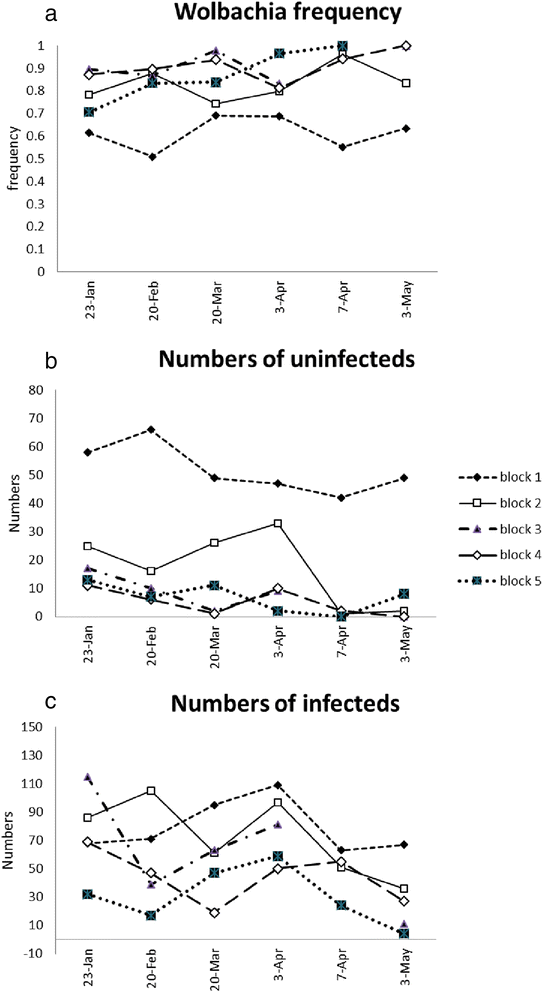
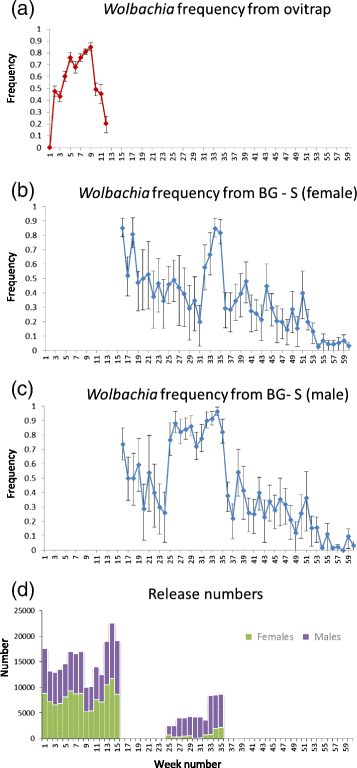
Similar articles
-
Characterizing the Aedes aegypti population in a Vietnamese village in preparation for a Wolbachia-based mosquito control strategy to eliminate dengue.PLoS Negl Trop Dis. 2009 Nov 24;3(11):e552. doi: 10.1371/journal.pntd.0000552. PLoS Negl Trop Dis. 2009. PMID: 19956588 Free PMC article.
-
The wMel Wolbachia strain blocks dengue and invades caged Aedes aegypti populations.Nature. 2011 Aug 24;476(7361):450-3. doi: 10.1038/nature10355. Nature. 2011. PMID: 21866159
-
Optimal control approach for establishing wMelPop Wolbachia infection among wild Aedes aegypti populations.J Math Biol. 2018 Jun;76(7):1907-1950. doi: 10.1007/s00285-018-1213-2. Epub 2018 Feb 10. J Math Biol. 2018. PMID: 29429122
-
Can Wolbachia be used to control malaria?Mem Inst Oswaldo Cruz. 2011 Aug;106 Suppl 1:212-7. doi: 10.1590/s0074-02762011000900026. Mem Inst Oswaldo Cruz. 2011. PMID: 21881776 Review.
-
The Use of Wolbachia by the World Mosquito Program to Interrupt Transmission of Aedes aegypti Transmitted Viruses.Adv Exp Med Biol. 2018;1062:355-360. doi: 10.1007/978-981-10-8727-1_24. Adv Exp Med Biol. 2018. PMID: 29845544 Review.
Cited by
-
The wMel strain of Wolbachia Reduces Transmission of Zika virus by Aedes aegypti.Sci Rep. 2016 Jul 1;6:28792. doi: 10.1038/srep28792. Sci Rep. 2016. PMID: 27364935 Free PMC article.
-
Modelling the ecological dynamics of mosquito populations with multiple co-circulating Wolbachia strains.Sci Rep. 2022 Dec 2;12(1):20826. doi: 10.1038/s41598-022-25242-x. Sci Rep. 2022. PMID: 36460676 Free PMC article.
-
Evolutionary Ecology of Wolbachia Releases for Disease Control.Annu Rev Genet. 2019 Dec 3;53:93-116. doi: 10.1146/annurev-genet-112618-043609. Epub 2019 Sep 10. Annu Rev Genet. 2019. PMID: 31505135 Free PMC article. Review.
-
Establishment of Wolbachia Strain wAlbB in Malaysian Populations of Aedes aegypti for Dengue Control.Curr Biol. 2019 Dec 16;29(24):4241-4248.e5. doi: 10.1016/j.cub.2019.11.007. Epub 2019 Nov 21. Curr Biol. 2019. PMID: 31761702 Free PMC article.
-
A Review: Aedes-Borne Arboviral Infections, Controls and Wolbachia-Based Strategies.Vaccines (Basel). 2021 Jan 8;9(1):32. doi: 10.3390/vaccines9010032. Vaccines (Basel). 2021. PMID: 33435566 Free PMC article. Review.
References
Publication types
MeSH terms
LinkOut - more resources
Full Text Sources
Other Literature Sources
Medical

